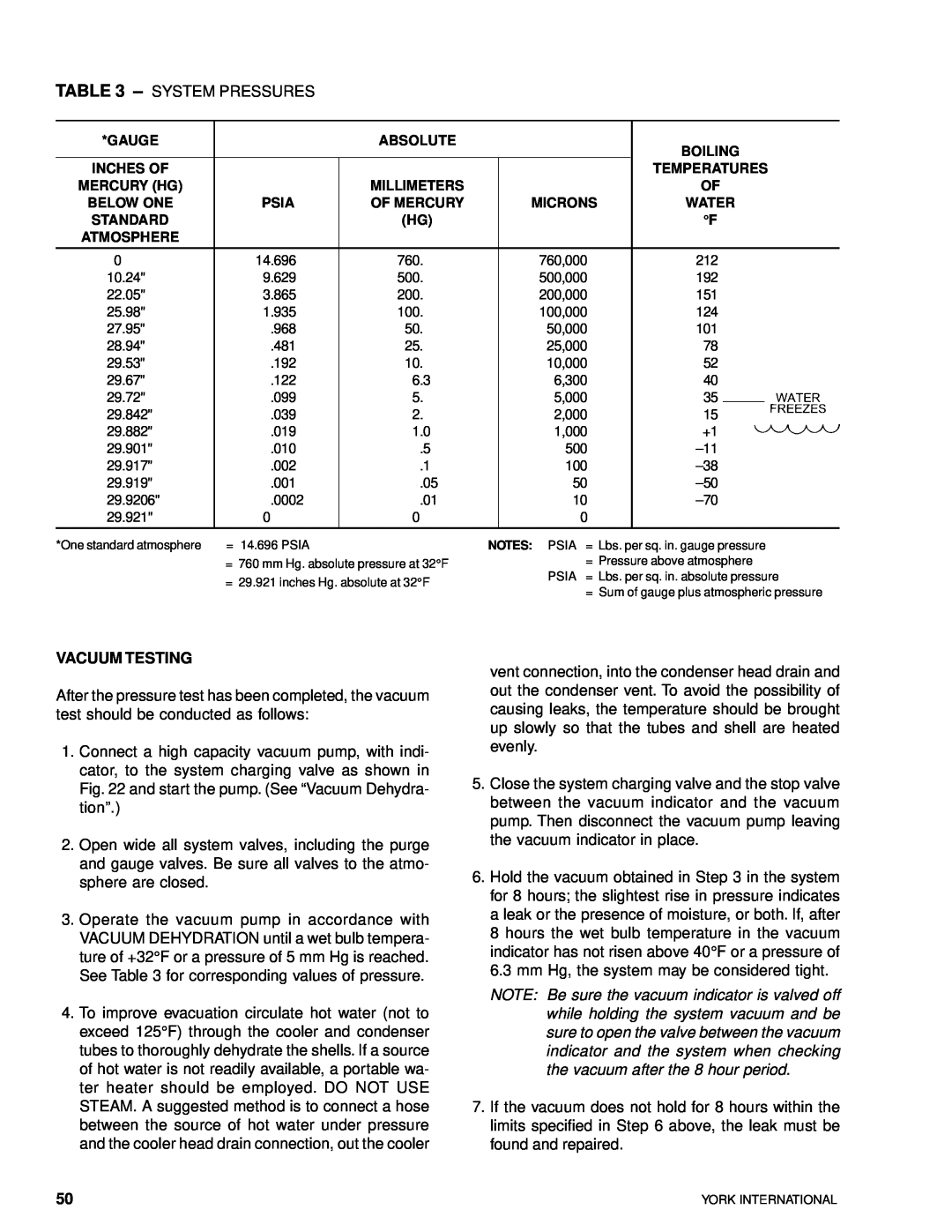TABLE 3 – SYSTEM PRESSURES
*GAUGE |
| ABSOLUTE |
| BOILING | ||
|
|
|
| |||
INCHES OF |
|
|
| TEMPERATURES | ||
MERCURY (HG) |
| MILLIMETERS |
| OF | ||
BELOW ONE | PSIA | OF MERCURY | MICRONS | WATER | ||
STANDARD |
| (HG) |
| °F | ||
ATMOSPHERE |
|
|
|
|
|
|
|
|
|
|
|
|
|
0 | 14.696 | 760. | 760,000 | 212 |
|
|
10.24" | 9.629 | 500. | 500,000 | 192 |
|
|
22.05" | 3.865 | 200. | 200,000 | 151 |
|
|
25.98" | 1.935 | 100. | 100,000 | 124 |
|
|
27.95" | .968 | 50. | 50,000 | 101 |
|
|
28.94" | .481 | 25. | 25,000 | 78 |
|
|
29.53" | .192 | 10. | 10,000 | 52 |
|
|
29.67" | .122 | 6.3 | 6,300 | 40 |
|
|
29.72" | .099 | 5. | 5,000 | 35 |
|
|
29.842" | .039 | 2. | 2,000 | 15 |
|
|
29.882" | .019 | 1.0 | 1,000 | +1 |
|
|
29.901" | .010 | .5 | 500 | |||
29.917" | .002 | .1 | 100 | |||
29.919" | .001 | .05 | 50 | |||
29.9206" | .0002 | .01 | 10 | |||
29.921" | 0 | 0 | 0 |
|
|
|
|
|
|
|
|
|
|
*One standard atmosphere | = 14.696 PSIA | NOTES: PSIA | = Lbs. per sq. in. gauge pressure | |
| = | 760 mm Hg. absolute pressure at 32°F |
| = Pressure above atmosphere |
| = | 29.921 inches Hg. absolute at 32°F | PSIA | = Lbs. per sq. in. absolute pressure |
|
|
| ||
= Sum of gauge plus atmospheric pressure
VACUUM TESTING
After the pressure test has been completed, the vacuum test should be conducted as follows:
1.Connect a high capacity vacuum pump, with indi- cator, to the system charging valve as shown in Fig. 22 and start the pump. (See “Vacuum Dehydra- tion”.)
2.Open wide all system valves, including the purge and gauge valves. Be sure all valves to the atmo- sphere are closed.
3.Operate the vacuum pump in accordance with VACUUM DEHYDRATION until a wet bulb tempera- ture of +32°F or a pressure of 5 mm Hg is reached. See Table 3 for corresponding values of pressure.
4.To improve evacuation circulate hot water (not to exceed 125°F) through the cooler and condenser tubes to thoroughly dehydrate the shells. If a source of hot water is not readily available, a portable wa- ter heater should be employed. DO NOT USE STEAM. A suggested method is to connect a hose between the source of hot water under pressure and the cooler head drain connection, out the cooler
vent connection, into the condenser head drain and out the condenser vent. To avoid the possibility of causing leaks, the temperature should be brought up slowly so that the tubes and shell are heated evenly.
5.Close the system charging valve and the stop valve between the vacuum indicator and the vacuum pump. Then disconnect the vacuum pump leaving the vacuum indicator in place.
6.Hold the vacuum obtained in Step 3 in the system for 8 hours; the slightest rise in pressure indicates a leak or the presence of moisture, or both. If, after 8 hours the wet bulb temperature in the vacuum indicator has not risen above 40°F or a pressure of 6.3 mm Hg, the system may be considered tight.
NOTE: Be sure the vacuum indicator is valved off while holding the system vacuum and be sure to open the valve between the vacuum indicator and the system when checking the vacuum after the 8 hour period.
7.If the vacuum does not hold for 8 hours within the limits specified in Step 6 above, the leak must be found and repaired.
50 | YORK INTERNATIONAL |
